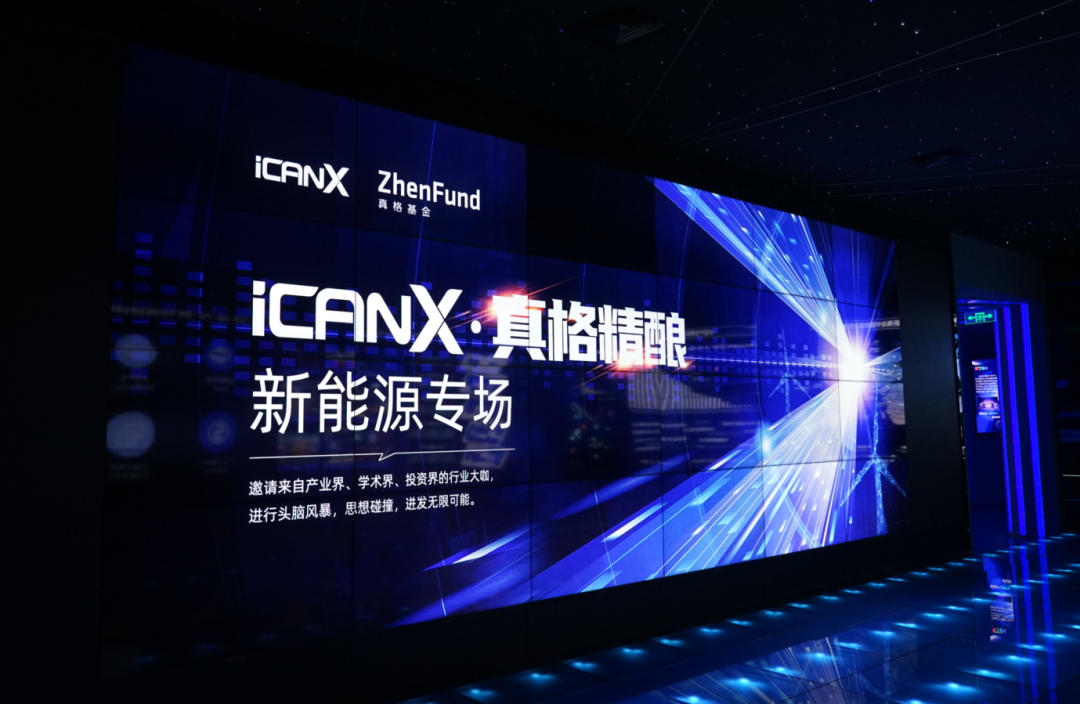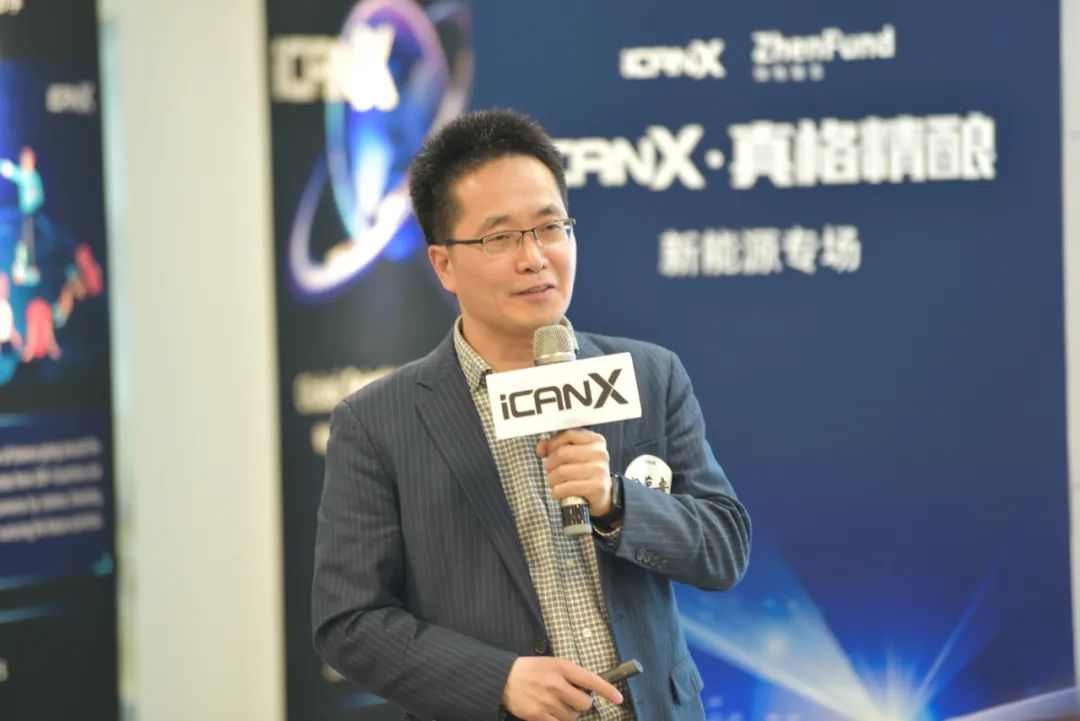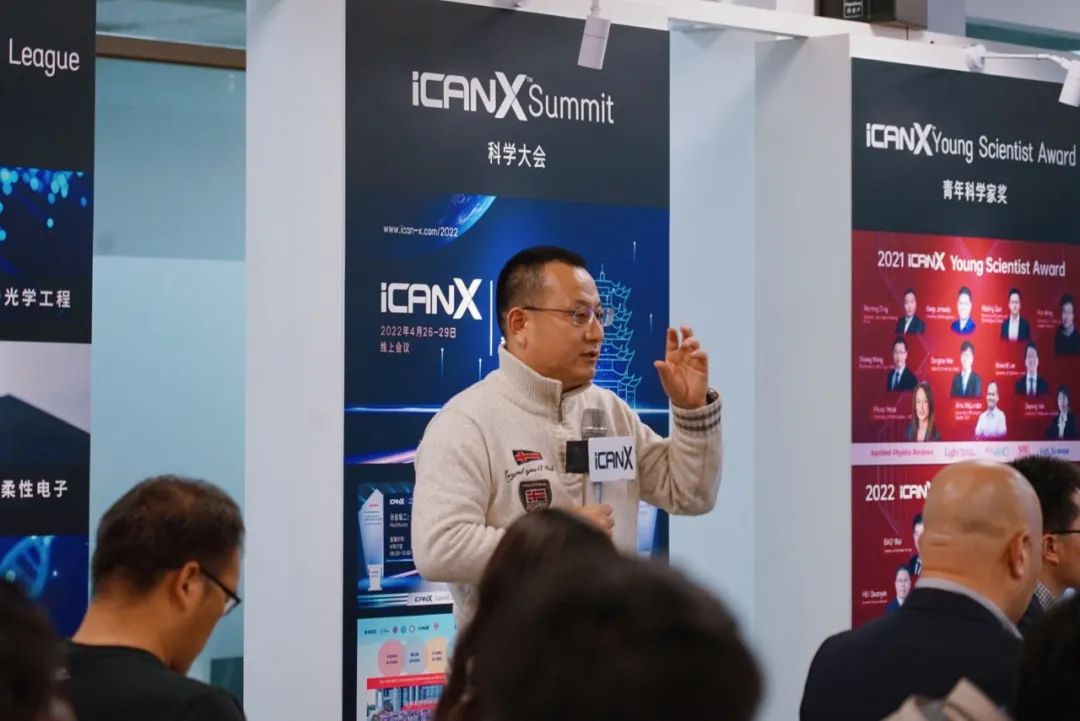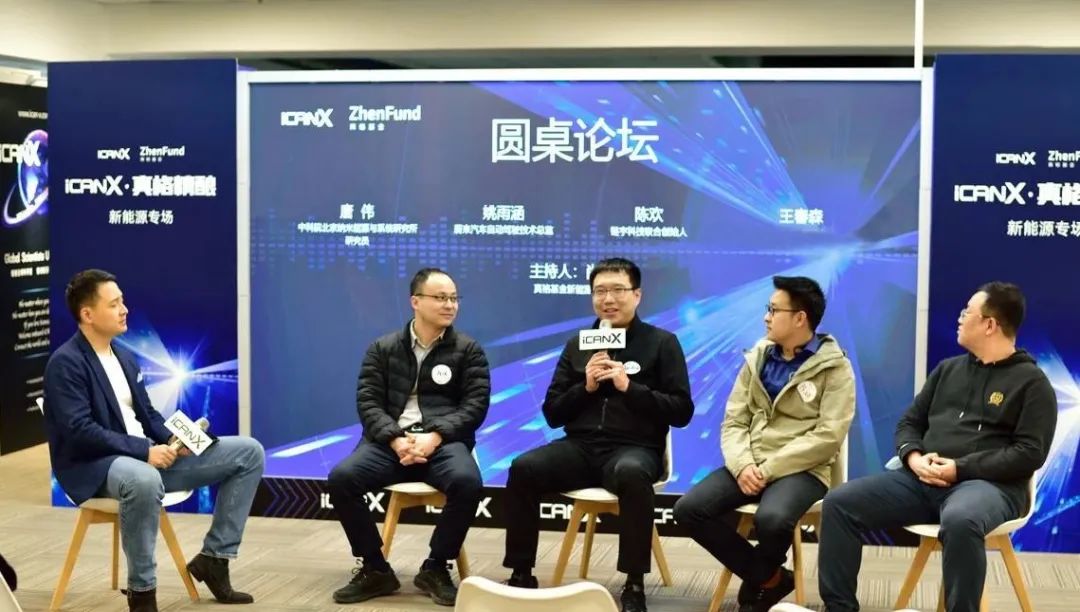
On March 18th, ZhenFund and iCANX jointly held a closed-door event of "iCANX·ZhenFund - New Energy Session
" , and invited more than 30 experts in the field of new energy from academia, industry and investment circles. Experts conducted in-depth exchanges and discussions on topics such as energy storage, batteries, and energy transformation.
iCANX is a global scientific exchange platform co-sponsored by many world-renowned scientists. Based on scientific exploration, it promotes the development of technological innovation and creates an ecosystem centered on global scientists. It is committed to spreading global cutting-edge scientific and technological innovations and promoting international scientific exchanges. cooperate with.
ZhenFund has been paying attention to the field of new energy for a long time, and has participated in many projects such as Weijing Energy Storage, Lianyu Technology, Hanwei Technology, and Hyde Hydrogen Energy. From the birth of scientific research to real commercial implementation, there is a long way to go, and it will also go through trials in the torrent of rapid progress, challenges and opportunities coexist .

New power system and high temperature thermal energy storage technology
Sharer: Yang Ronggui, Professor, School of Energy, Huazhong University of Science and Technology
High-temperature thermal energy storage technology is expected to become "the backbone of future large-scale energy storage"
There is a big gap between China and the European Union and the United States in realizing the vision and goal of carbon peaking and carbon neutrality, and the time is tighter, the scale is bigger, and the difficulties are more difficult. The task is very arduous . At present, the world's carbon emissions are 36 billion tons per year, while China's is 10 billion tons, ranking first in the world, of which nearly 45% actually comes from the power industry. Under the background of dual carbon, it is estimated that by 2060, renewable energy such as wind and light will replace thermal power as the main power source of the power system. However, this type of new energy is highly volatile, and a large number of introductions will have an impact on the power grid, and even lead to large-scale power outages. The most typical example is the sudden large-scale power outage in Texas the year before last. This requires us to establish a new type of power system centered on large-scale long-term energy storage to continuously and stably absorb renewable energy. Only in this way can we ensure that we have better and stable energy.
To achieve this goal, it is necessary to introduce a new type of large-scale heat storage technology - high temperature thermal energy storage technology . This technique has many advantages:
1. Can achieve high power (more than 100 MW) and long-term energy storage (more than 4 hours);2. Not limited by geographical and environmental factors, it is more flexible and applicable than other long-term energy storage technologies;3. The investment cost of thermal energy storage is significantly lower than that of battery energy storage, and the cost per unit of electricity is also much lower than other energy storage technologies.
High-temperature thermal energy storage helps create new power systems
On the power generation side, the thermal energy storage system can be coupled with thermal power plants, using excess new energy or off-peak electricity to charge the thermal energy storage system, and release heat to generate electricity during peak periods of power consumption, realizing the flexible transformation of thermal power units. In this way, the original power plant is transformed into a new type of energy storage power station, so that large-scale energy storage can be carried out.
On the power consumption side, industrial production such as cement, ceramics, or steel requires a lot of heat energy. In this process, its carbon emissions are also very important. If heat storage is used to replace the original coal burning, not only can it have very high efficiency, but it can also reduce a lot of carbon emissions. In the future, if there is thermal energy storage, a new power system can be built to accommodate renewable energy.


All-vanadium redox flow battery and its safe and efficient utilization technology
Sharer: Li Xin, associate professor of Hefei University of Technology
All-vanadium redox flow battery boosts energy storage technology and industrial development
China has proposed many technical routes and standards in the field of flow batteries, including the design, maintenance, operation, and power testing of flow batteries, which provide good conditions for the development of flow batteries. We believe that flow batteries are the most commercially viable batteries for long-term energy storage . Its core advantage is that its cycle times can reach 20,000 times, it has a large storage capacity, is safe and reliable, and is green and recyclable . Moreover, compared with lithium-ion batteries, the cost of using flow batteries is very low. Furthermore, from the perspective of resources, my country also has greater advantages. Compared with lithium, the proportion of vanadium resources in China is about 5.5 times that of lithium, and the proportion of China + Russia is 60% of the world. At the same time, vanadium has the best safety, no potential explosion or fire risk; long life, low cost of electricity, low maintenance and recycling costs.
Facing opportunities and challenges, comprehensively upgrading industry-university-research
After nearly 20 years of development, the energy storage industry has become very large. This year, it was discovered that lithium batteries have begun to oversupply. This requires us to be vigilant, whether similar problems will occur in flow batteries. We believe that there are two main paths for the future development of the industry market: first, the production method is specialized and standardized; second, the application scenarios must be precise and intelligent, and it is unreasonable for one product to dominate the world. In addition, we also need to pay attention to the development of several core technologies, including: electrolyte production process and continuous service capability; wide temperature stack technology, low temperature stack technology, high overload stack technology; and intelligent technology for system integration.
In the entire upgraded industry-university-research system, there are three important components:
1. The following is "land" : including the industrial support of central enterprises, state-owned enterprises, and leading enterprises, and the service capabilities of enterprises. These are very critical. Without "land", development cannot continue;2. The above is "Heaven": including the development of local new energy, the ability of the government to govern, the development of industry and commerce, etc.;3. There are 3 steps in the middle: First, there must be an innovative team. Innovation must go through the test, and innovation must come out . In addition, there must be a martial arts training ground, that is, laboratories, research centers, and engineering technology centers. The next step is to make products, mix industrialization, and whether there is an industrial fund.


Industrial Energy Efficiency Revolution Driven by Data and AI
Sharer: Xiao Guang, new energy consultant of ZhenFund
Using data and AI to drive the industrial energy efficiency revolution
Basic industry is the absolute main force of energy consumption and carbon emissions, and industrial production accounts for more than 50% of carbon emissions. There are roughly four ways to reduce carbon emissions. The first is demand reduction, but this is a false proposition, because you cannot curb the growing living needs of the masses; the second is the adjustment of energy structure, gradually changing from coal power to wind and light; the third is decarbonization; the third is decarbonization; The fourth is to improve energy efficiency. This method requires less investment and quick results.
China's industrial energy efficiency improvement space is generally 30% - 40%. On the path of energy conservation, energy efficiency is the first energy source . In order to truly achieve energy saving, on the one hand, it is to increase the utilization rate of production capacity, and on the other hand, it is to promote the industry, carry out mergers and acquisitions, and gradually eliminate backward production capacity. But now we have entered a deep water area of intelligence. In the process from automation to intelligence, the human brain has been overwhelmed. At the system level, how to operate these systems has become a big challenge.
In factories, automation solves the physical labor problems of workers, but it does not solve the mental labor problems of engineers. The judgment of engineers is still based on experience and traditional methods. The core of intelligence is to solve the problem of mental work of engineers . This part of the real-time data-driven intelligent operation is a rapidly growing blue ocean demand. In the future, we feel that we can achieve Energy Scheduling 3.0, uninterrupted intelligent navigation, and truly realize the intelligent use of complex energy systems. Intelligent navigation, step by step to complete the leap. Just as the autonomous navigation of automobiles lays the foundation for self-driving, smart energy navigation can also provide industrial enterprises with auxiliary decision-making for energy operation like automobile navigation.
It is a good time for virtual power plants to enter the market
Under the innovation of today's new energy system, it is also possible to turn costs into assets through energy conservation. Intelligent demand response, especially the participatory response of large energy-consuming equipment, is a long-neglected opportunity. Before, our country’s virtual power plants also encountered some challenges, but under a series of market changes and policies today, we believe that we have reached a potential point of change:
1. From the perspective of the power grid, the pressure of peak and valley regulation is increasing, and there is an urgent need for market-oriented load regulation;
2. For large industrial energy users, the peak power consumption will be cut off by power cuts, seriously affecting production and efficiency; the dual-carbon policy leads to a decrease in carbon emission quotas year by year, all of which are pressures brought by policy compliance;
3. For electricity sales companies and virtual power plants, policy support has made the market more free, with more participants entering, the demand for power grids and large power plants is strong and urgent. At present, the virtual power plant is in the stage of transition from invitation-based to market-based, and its development is relatively elementary, and there is a lot of room for development in the future. Based on the 10% growth rate of electricity consumption, it is estimated that the virtual power plant market size in 2030 is conservatively estimated at 135 billion/year.


Roundtable Discussion
What is the biggest challenge that may be faced in the innovation ?
After the dual carbon targets were proposed, the oil and gas industry is facing great challenges , which is a revolutionary change in the industry. From a global perspective, Europe and the United States have entered the oil and gas age, and China is still in the coal age. It is a leap from the coal age to the low-carbon age. From this perspective, our traditional energy is facing great challenges, but what we need to do now is to make traditional energy clean and low-carbon . We also have our own advantages: sufficient funds and better technology. Through different technological innovations, management models, etc., there will be great development prospects and space in the future.
—— Rui Zhenhua, Professor of China University of Petroleum (Beijing)
From the perspective of the energy system, after the proposal of carbon neutrality in the past two years, it seems that all walks of life and all levels are doing it, but to achieve this goal, there will be many challenges: for example, industries such as the aviation industry, it is very difficult Realize carbon neutrality; for example, in regions like Ordos that produce a lot of coal, it is not realistic to achieve double carbon simultaneously with the whole country. Special consideration should be given to such industries and regions. So there is such a problem as first easy and then difficult, which industries and regions to do first, which requires a step-by-step process and clear policy guidelines.
——Zhang Chuan, Double-appointed researcher at Peking University Energy Research Institute and Carbon Neutral Research Institute
Whether it is wearable electronics in daily activities or sensors in industrial production, they currently rely on the micro-energy provided by batteries, and the extensive use of batteries has problems of difficult maintenance and environmental pollution. Self-powered technology has become an urgent need for sensors. and great impetus . On the one hand, human body movement will generate a large amount of micro-mechanical energy, which can be easily obtained by using self-powered technology to realize self-powered wearable electronics and promote the development of intelligent body area networks. On the other hand, the operation of industrial machinery and equipment will also generate a large amount of micro-mechanical energy. Collecting these micro-energy can realize the self-power supply of sensors and help the development of intelligent industrial Internet of Things.
—— Zhang Chi, Researcher at Beijing Institute of Nano Energy and Systems, Chinese Academy of Sciences
The industrial chain has periodic ups and downs every once in a while. On the one hand, the upstream and downstream links of photovoltaics span multiple technical manufacturing fields. The speed and law of capacity expansion in each link are different, and the internal upstream and downstream relationships and supply relationships of each link are also different. It is difficult for the entire industry to achieve a more balanced one. state. On the other hand, changes in the relationship between supply and demand will lead to differences in the profit distribution structure of each link in the industrial chain in different periods. Once many Chinese companies find that a link is profitable, they will increase capital investment, which will trigger a new round of overcapacity in this link. . Therefore, if an enterprise wants to develop sustainably in the energy transition, it needs to have its own determination and thinking, and do what it is good at according to its core competitiveness and business rhythm .
——Zhang Zhechi, Director of Global Corporate Development and Strategy, LONGi

Imagine the energy usage scenario you want to see ten years from now?
I work in nanotechnology, and I hope that in the future there will be some energy supplies implanted in living organisms, such as micro-nano robots implanted in living organisms, and we can directly supply power to them through some new energy technologies to eliminate diseases. Guarantee our life and health and maintain physical signs.
——Tang Wei
Researcher, Beijing Institute of Nano Energy and Systems, Chinese Academy of Sciences
I hope that in the future, the power supply will always be stable and sufficient, and the cost will be controllable. For cars, I hope that the energy density can be further increased, so that new energy vehicles can replace fuel vehicles faster and help carbon reduction policies. In addition, if there is more electricity, we can also reduce the occurrence of accidents based on these electricity, so that higher levels of automatic driving in the future will truly liberate us from driving tasks.
——Yao Yuhan
Director of Autonomous Driving Technology, NIO
I think 10 years from now, the whole society will enter an era of deeper electrification . In the field of transportation, scenarios such as electrified roads and pure electric aircraft will gradually mature and become commercially available. In addition, vehicle-network interaction will be organically combined with autonomous driving . Vehicle travel, charging and discharging interactions between vehicles and the grid are all planned and managed by AI. People no longer have mileage anxiety, and a large number of ToC-end electric vehicles are truly integrated into the power system , becoming power banks and energy sponges of the power system, providing the most economical, flexible and safest energy storage for new energy power generation, and relying on the car network Interactive in-depth empowerment, the era of comprehensive clean and low-carbon energy use will come .
—— Chen Huan
Co-founder of Lianyu Technology
